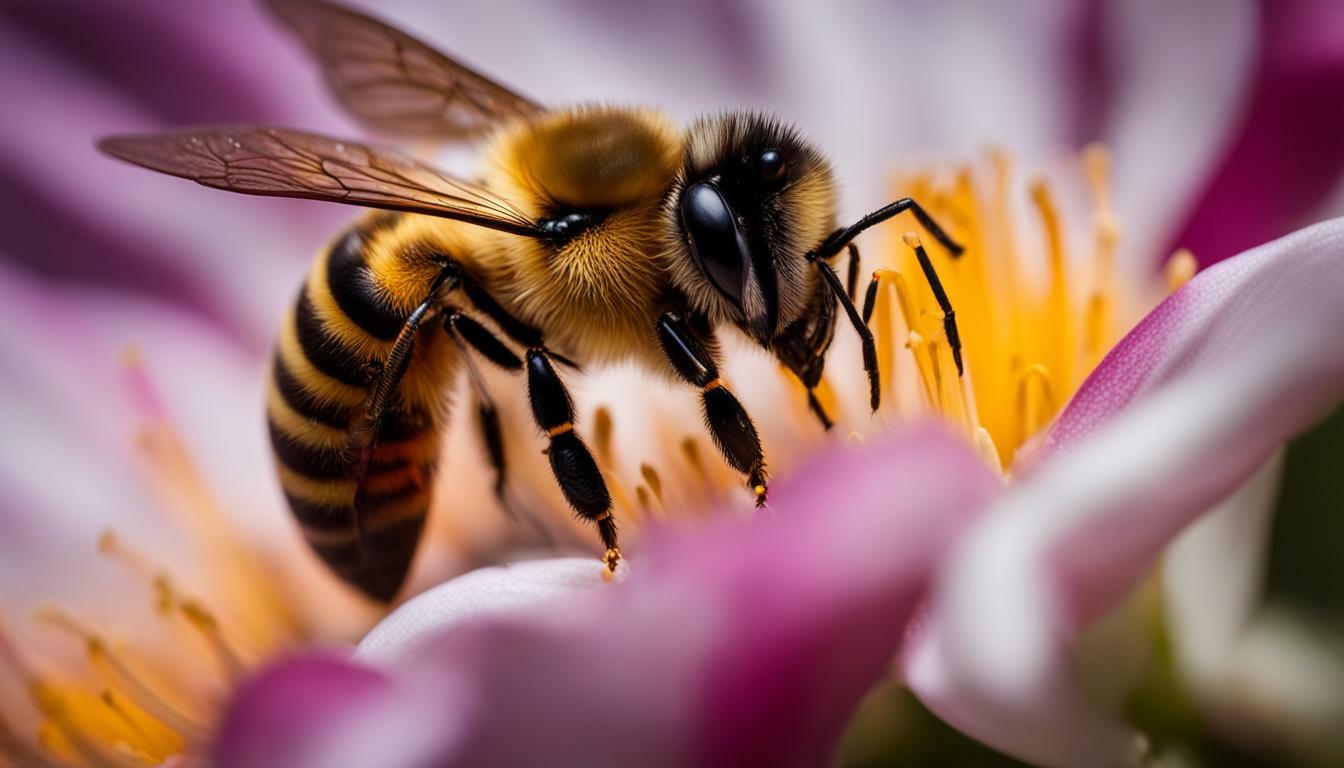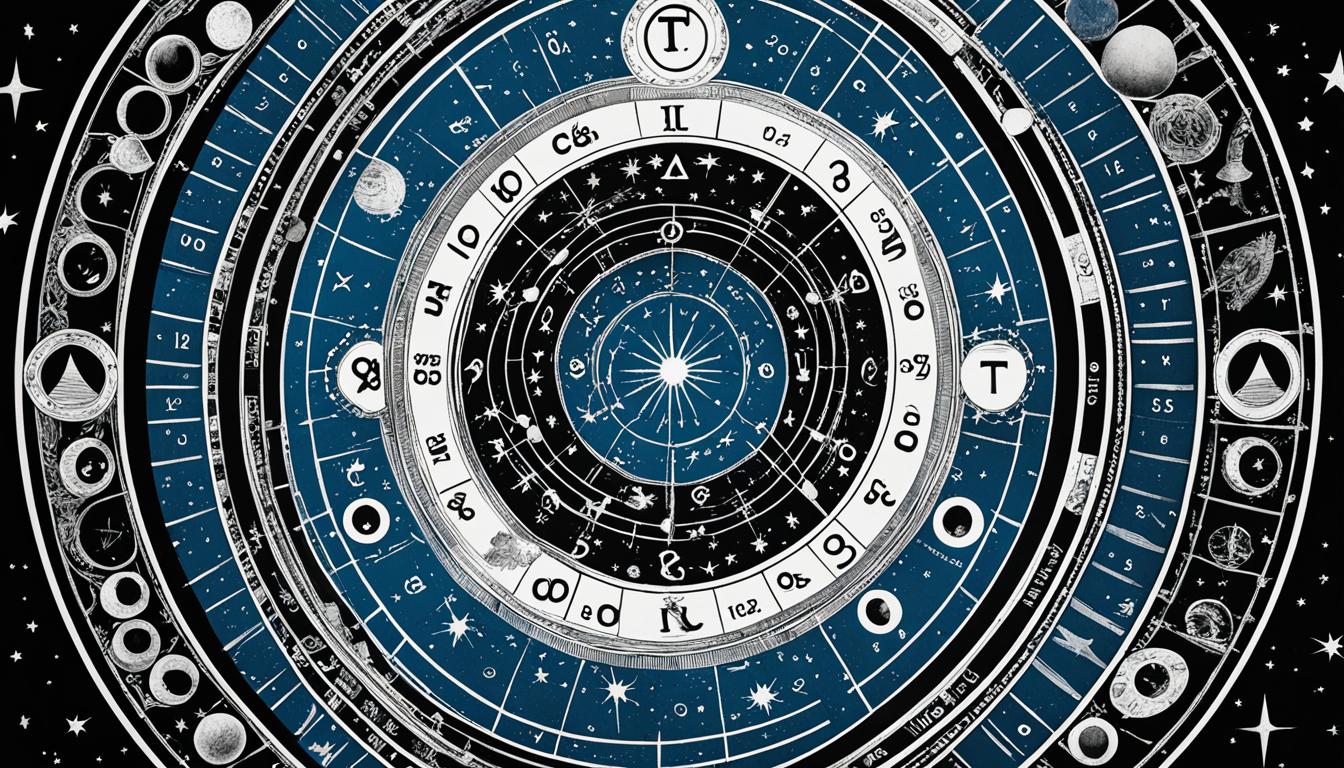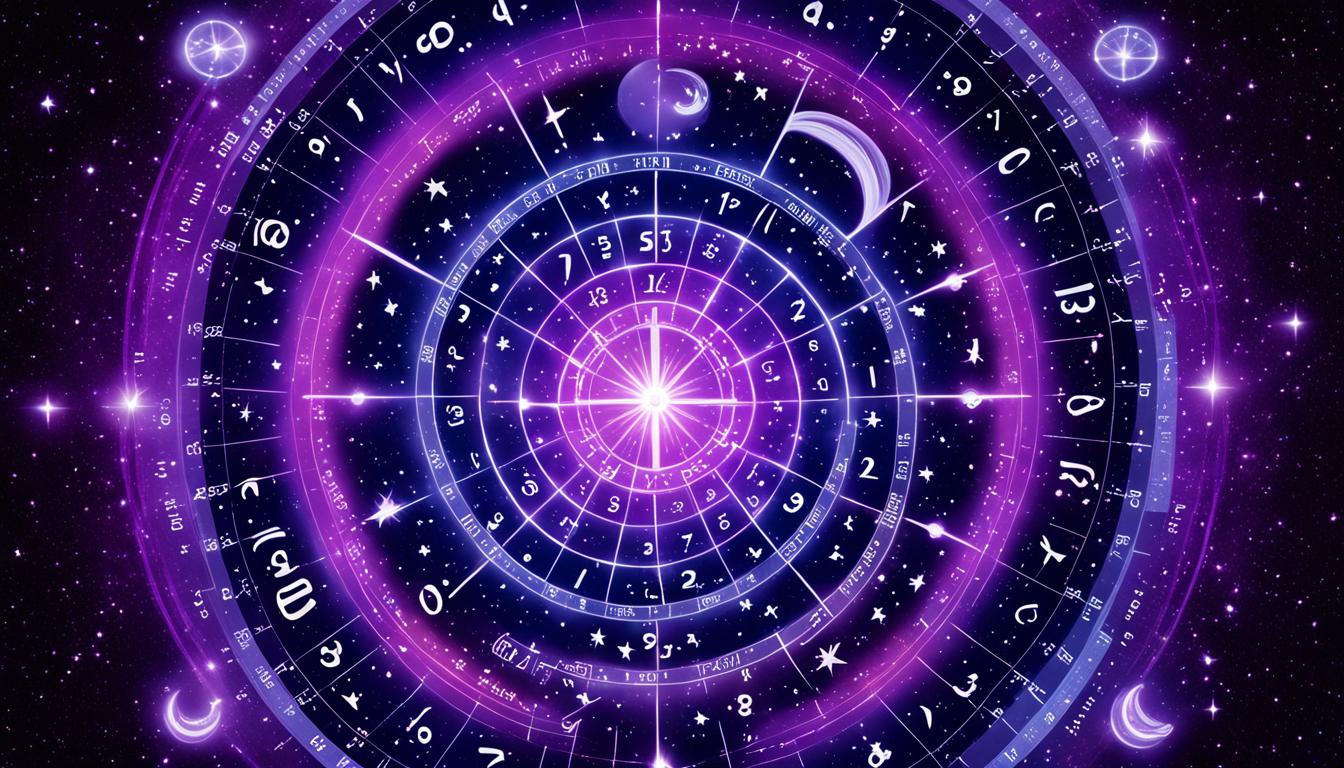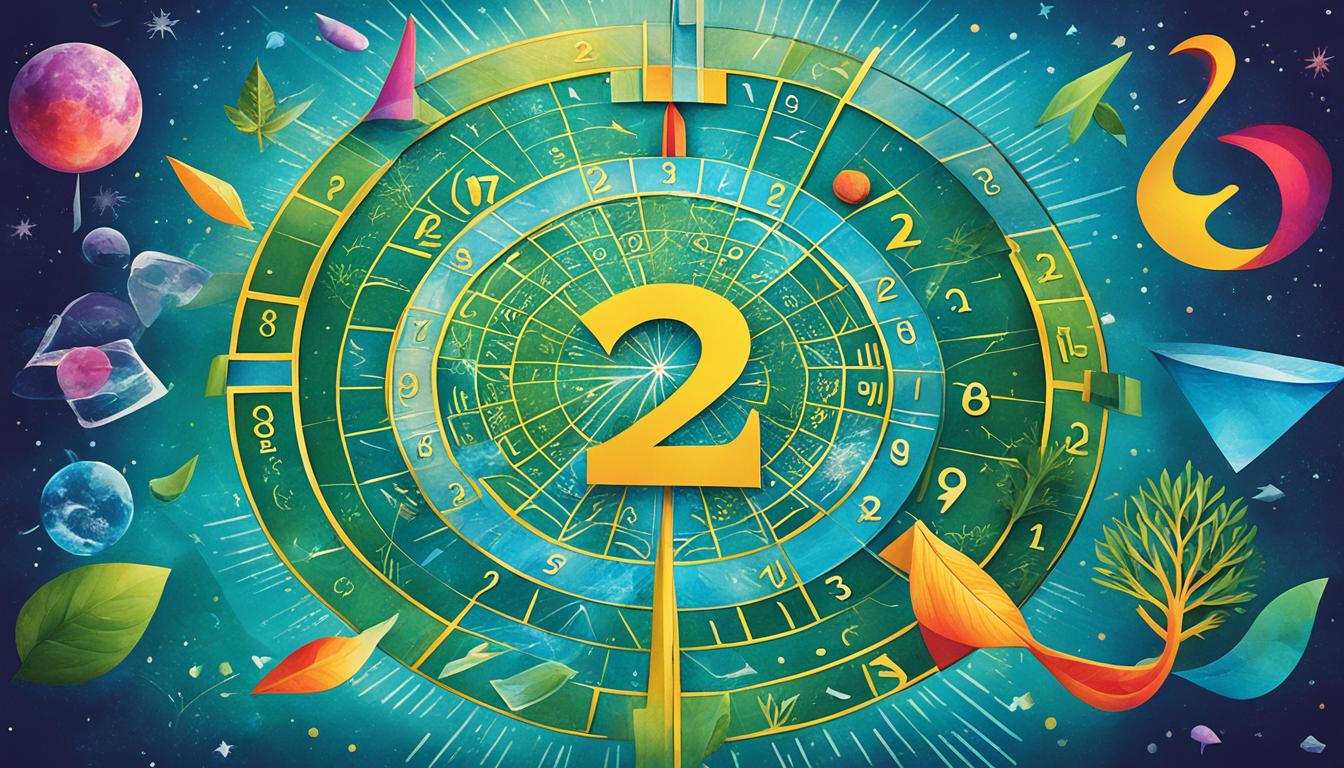Bee sting symbolism has intrigued and fascinated cultures around the world for centuries. The mysterious and potent nature of bee stings has sparked various interpretations and beliefs, making it a symbol rich in meaning and spiritual significance.
Bees, with their intricate social structure and interconnectedness, are seen as a symbol of community and harmony. The symbolism of bee stings reflects the lessons of working together, highlighting the importance of unity and cooperation among individuals.
Additionally, bee stings carry a metaphorical sting of truth, serving as a reminder of the consequences that come with our actions. It urges us to reassess our choices and behaviors, encouraging personal growth and self-reflection.
In many cultures, bee stings are believed to possess healing properties and are associated with transformation. The spiritual message behind bee stings is often seen as a catalyst for inner change and a path towards spiritual enlightenment.
The journey from childhood to adulthood is symbolized by bee sting ceremonies in some cultures. These rituals represent a rite of passage, marking the transition into maturity and the responsibility that comes with it.
However, bee sting symbolism is not solely positive. The aggressive nature of bees and their ability to protect their hive symbolizes the darker side of bee sting symbolism. It represents the determination to stand up against adversity and protect oneself.
Bee stings also hold significance in ancient mythology, with associations to love, desire, and the powerful nature of romantic relationships. They embody the intensity and passion that often accompanies such connections.
Furthermore, bee stings are believed to bring luck and offer protection against evil in folklore and superstitions. They are seen as a symbol of purification and a shield against negative forces.
It is important to note that the interpretation of bee sting symbolism can vary across different cultures and belief systems. The subjective nature of its meaning allows individuals to find personal significance in its symbolism.
Key Takeaways:
- Bee sting symbolism is a topic that has intrigued cultures around the world for centuries.
- It represents various concepts such as community, interconnectedness, truth, healing, transformation, and protection.
- Bee sting symbolism is also associated with love, luck, and purification.
- Interpretations of bee sting symbolism can vary across different cultures and belief systems.
The Bee as a Symbol of Community and Interconnectedness
In many cultures, the bee itself is seen as a symbol of community, hard work, and cooperation. This symbolism extends to bee stings, which are often interpreted symbolically as well. A bee sting can represent the interconnectedness of all living beings and the importance of working together for the greater good.
Bees are known for their highly organized social structure within their hives. Each bee has a specific role and contributes to the functioning of the colony as a whole. This cooperative nature of bees is often seen as a reflection of how communities should function, with each individual playing their part for the benefit of everyone.
The symbolism of bee stings emphasizes the significance of our actions and their impact on others. Just as a bee sting can cause pain and discomfort, our choices and behaviors can have ripple effects that affect those around us. This symbolism serves as a reminder to consider the consequences of our actions and to strive for harmony and cooperation in our relationships with others.
The Bee as a Symbol of Community and Interconnectedness
The significance of bee stings can also be seen in the context of environmental conservation and the interconnectedness of ecosystems. Bees play a crucial role in pollination, enabling the reproduction of many plant species. Without bees, the delicate balance of ecosystems would be disrupted, affecting not only plants but also animals and humans that depend on them for food and other resources.
“The bee is more honored than other animals, not because it labors, but because it labors for others.” – Saint John Chrysostom
This quote highlights the selflessness and communal nature of bees, emphasizing the importance of working together for the benefit of all. Bee stings, in this context, symbolize the interconnectedness of all living beings and the need to protect and preserve our natural world.
- Bees are often considered a symbol of fertility and abundance as they play a vital role in pollinating flowers and crops.
- Many ancient cultures revered bees and saw them as messengers between the divine and human realms.
- The ancient Egyptians associated bees with their sun god Ra and believed that bees emerged from the tears of Ra.
- In Greek mythology, bees were associated with the goddess Artemis, who was often depicted with bees and honey.
In conclusion, the symbolic interpretation of bee stings highlights the bee’s role as a symbol of community, hard work, and interconnectedness. Bee stings remind us of the importance of our actions and their impact on others. By embracing the lessons from bee sting symbolism, we can strive for harmony, cooperation, and environmental conservation in our own lives and communities.
The Metaphorical Sting of Truth and Lessons Learned
The bee sting, however, adds another layer of symbolism to this already complex image. It serves as a metaphor for facing the consequences of our actions and reassessing our choices and behaviors. Just as a bee sting can cause temporary pain and discomfort, it also provides valuable lessons and opportunities for growth.
“The sting of a bee can be a wake-up call, a jolt of truth that forces us to confront our shortcomings and make necessary changes,” says Dr. Elizabeth Thompson, a renowned psychologist specializing in symbolism. “It serves as a reminder that our actions have consequences and that we must take responsibility for our choices.”
The interpretation of bee stings goes beyond the physical realm. It delves into the hidden meanings and messages that can be derived from this seemingly innocuous event. The sting of a bee can serve as a wake-up call, a reminder that we should pay attention to the lessons life is trying to teach us.
Through the metaphorical sting of truth, we are encouraged to reflect on our actions, behaviors, and decisions. It prompts us to reassess our priorities, question our beliefs, and make necessary changes to align with our true purpose. The sting of a bee symbolizes the discomfort and unease that often accompanies personal growth and transformation.
Just as a bee sting can leave a temporary mark on our bodies, the lessons learned from the metaphorical sting can leave a lasting impact on our lives. It challenges us to confront our fears, overcome obstacles, and evolve as individuals. The hidden meaning of bee stings lies in their ability to push us out of our comfort zones and propel us towards personal development.
Dr. Thompson explains, “The hidden message behind bee stings is that growth often comes from discomfort. By embracing the sting and the lessons it brings, we can emerge stronger, wiser, and more resilient.”
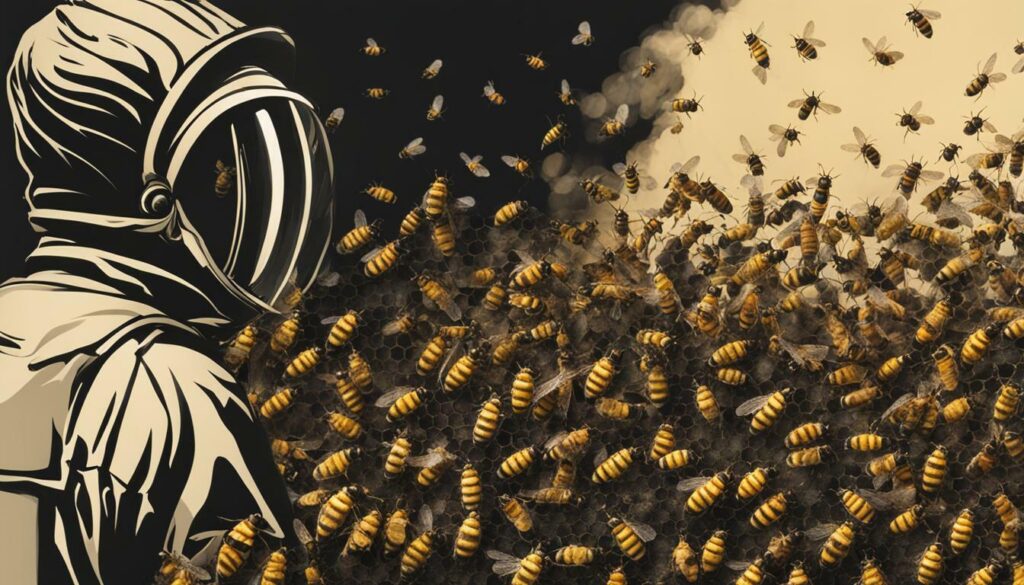
Adding to the symbolism of the bee sting is the fact that it is not a random occurrence. Just as bees carefully choose their target, the metaphorical sting of truth often presents itself at significant moments in our lives when we are ready to learn and grow.
By examining the hidden meaning of bee stings, we can gain valuable insights into our own lives and make conscious choices that align with our true selves. It is through these experiences of discomfort and growth that we can fully embrace the transformative power of the metaphorical sting and achieve personal enlightenment.
The Bee Sting Symbolism in Healing and Transformation
In certain spiritual and religious traditions, the bee sting is believed to possess healing properties. It is seen as a powerful symbol of transformation and spiritual growth. The sting of a bee is considered to carry a deep spiritual message, revealing valuable insights and guiding individuals towards self-discovery.
The symbolic interpretation of a bee sting centers around the idea that pain and discomfort can lead to profound healing and personal transformation. Just as the bee’s sting can cause temporary pain, it is believed to initiate a process of cleansing and purifying the spirit, allowing for growth and renewal.
According to alternative medicine practices, bee venom therapy, also known as apitherapy, utilizes bee stings to treat a variety of ailments. This therapy, rooted in ancient beliefs and practices, is based on the belief that the venom of bees possesses medicinal properties, capable of stimulating the immune system, reducing inflammation, and promoting overall well-being.
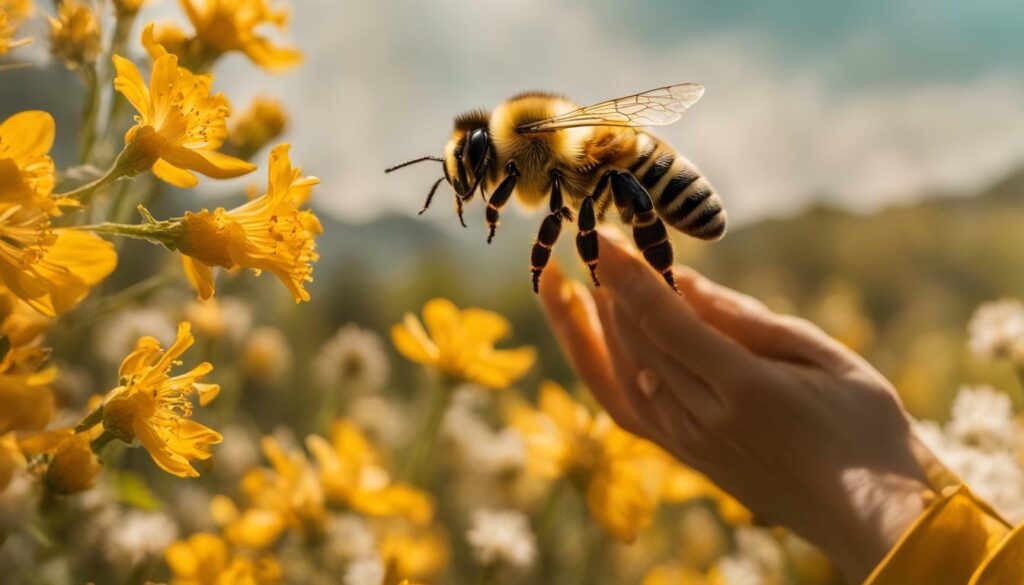
Bee Sting Therapy and Alternative Medicine
Apitherapy has been utilized by various cultures for centuries. In traditional Chinese medicine, bee sting therapy is believed to promote the flow of Qi energy, harmonizing the body’s energy and promoting healing.
| Condition | Benefits of Bee Venom Therapy |
|---|---|
| Rheumatoid arthritis | Reduces joint inflammation and pain |
| Multiple sclerosis | Improves immune system function |
| Chronic pain | Acts as a natural pain reliever |
| Neurological conditions | Enhances nervous system function |
In addition to its physical healing properties, bee sting symbolism is often associated with emotional and spiritual transformation. The pain of the sting is seen as a catalyst for personal growth and self-reflection. It is believed that facing and overcoming adversity can lead to profound changes in one’s mindset, perspective, and overall spiritual journey.
“The bee stings not only the body, but also the heart, piercing through layers of delusion and awakening the soul to a deeper understanding of oneself and the world.” – Spiritual Teacher
Symbolically, the bee sting reminds us that discomfort and challenges are essential for personal growth and transformation. It teaches us to embrace difficulties as opportunities for self-improvement and spiritual evolution.
The Spiritual Message Behind Bee Stings
The spiritual significance of bee stings lies in their ability to bring about a profound shift in consciousness. The pain and discomfort inflicted by the bee’s sting serve as powerful reminders of our own vulnerabilities and limitations.
Furthermore, the bee sting highlights the importance of mindful action and accountability. It encourages individuals to reflect on their choices and behaviors, recognizing the consequences they may bring.
- Symbolic interpretation of the bee sting:
- Awake to the truth of one’s actions and their impact on oneself and others
- Face the consequences of one’s choices and learn from them
- Transform personal pain into growth and wisdom
As individuals navigate the journey of life, the bee sting symbol serves as a reminder that through pain and discomfort, true transformation and spiritual awakening can be achieved.
The Bee Sting as a Rite of Passage
The bee sting can also symbolize spiritual transformation or initiation. In many cultures, bee sting ceremonies are considered a rite of passage, marking the journey from childhood to adulthood. These ceremonies hold deep symbolic significance and are often accompanied by rituals and traditions that highlight the transition and growth of individuals.
During these ceremonies, individuals are intentionally stung by bees, symbolizing the challenges and obstacles they must face in order to grow and mature. The bee sting represents the pain and discomfort that one must endure in order to gain wisdom, strength, and a deeper understanding of themselves and the world around them.
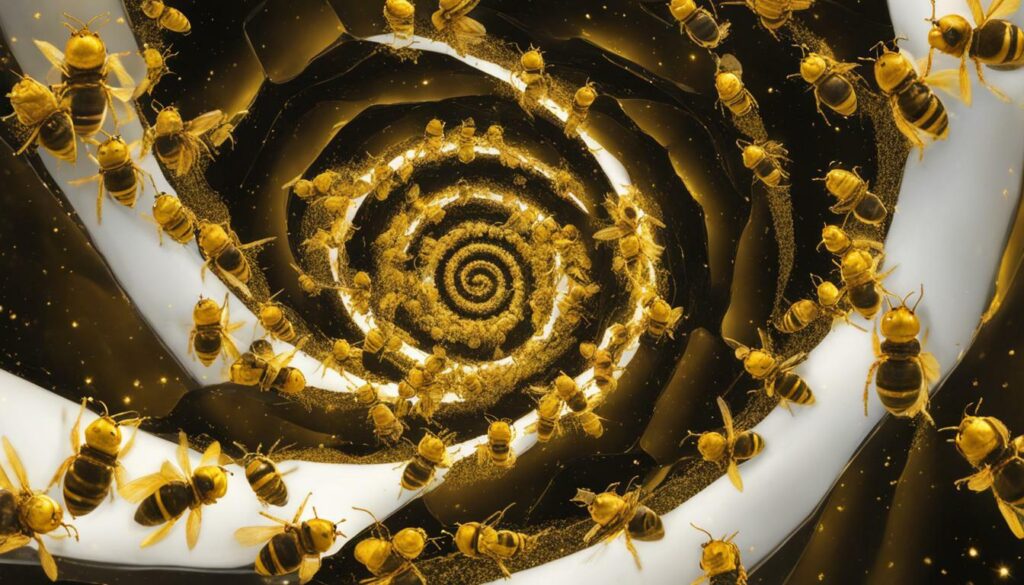
Just as a bee stings in defense of its hive, the act of willingly accepting a bee sting is seen as a courageous act of facing fears and embracing personal growth. It is believed that through this experience, individuals gain valuable life lessons and develop resilience and determination.
The Symbolic Meaning Behind Bee Sting Ceremonies
In these bee sting ceremonies, participants often undergo a purification process before and after the sting. This cleansing ritual is seen as a way to remove any negative energy or impurities, allowing individuals to undergo a spiritual transformation. The sting itself is believed to bring about a heightened state of consciousness, allowing individuals to connect with their higher selves and gain insight into their life’s purpose.
These ceremonies are deeply rooted in symbolism, with each aspect holding significant meaning. The bee sting represents the pain and challenges one must face in life, while the honey produced by bees symbolizes the sweetness and rewards that come from overcoming these challenges. The hive itself represents the interconnectedness of all beings and the importance of community in our journey towards self-discovery.
“The bee sting is a powerful symbol of growth and transformation. It reminds us that in order to reach our full potential, we must be willing to face discomfort and embrace the lessons that come our way.” – Bee Sting Expert
Participating in a bee sting ceremony is often seen as a transformative experience that marks the transition from childhood to adulthood. It is believed to awaken one’s inner strength, resilience, and capacity for growth, preparing individuals for the challenges that lie ahead on their life path.
Conclusion
Through bee sting ceremonies, individuals embark on a journey of self-discovery and spiritual transformation. The bee sting symbolizes the challenges and growth that one must face in order to mature and gain wisdom. These ceremonies highlight the interconnectedness of all beings and emphasize the importance of community and the lessons learned from facing adversity.
Aggression, Protection, and Defense: The Darker Side of Bee Sting Symbolism
The bee sting’s symbolism is not limited to positive or transformative meanings. In various cultures around the world, the act of being stung by a bee holds deeper significance, often associated with aggression, protection, and defense. While bees are typically seen as gentle pollinators and symbols of community, their sting carries a symbolic weight that extends beyond their nurturing nature.
In some Native American tribes, the bee sting is seen as a powerful defense mechanism. It is believed that the bee, when provoked, will sting its target to protect its hive and fellow bees. This symbolism of protection and defense resonates with the idea that individuals should stand up against adversity and defend themselves when necessary.
“The bee sting represents our inner strength and determination to confront challenges head-on. Just as the bee stings to protect its hive, we too must defend ourselves when faced with threats or injustice.”
– Elder John White Bear, Navajo Nation
In certain African cultures, bee stings are associated with aggression and the ability to assert oneself. The sting is seen as a metaphorical weapon that allows individuals to assert their dominance and protect their territory. It symbolizes the strength and power needed to navigate through life’s challenges and establish one’s place in the world.
Interestingly, the symbolic interpretation of bee stings in various cultures also extends to the concept of self-defense. In martial arts practices such as Muay Thai, the bee sting serves as a metaphor for quick, precise strikes that incapacitate opponents. It represents the need to react swiftly and assertively in protecting oneself from harm.
This darker side of bee sting symbolism reminds us that aggression and protection are integral parts of life. Just as bees fiercely guard their hives, we too must be prepared to defend ourselves and our loved ones when necessary. The bee sting serves as a reminder of the strength and determination required to confront challenges and overcome adversity.

| Culture | Interpretation |
|---|---|
| Native American | The bee sting symbolizes protection and defense. |
| African | Bee stings represent aggression and asserting dominance. |
| Martial Arts | Bee stings metaphorically represent quick, precise strikes for self-defense. |
In conclusion, the symbolism of bee stings goes beyond positive or transformative meanings. It encompasses aggression, protection, and defense, reminding us of the importance of standing up for ourselves and asserting our strength when faced with challenges. Understanding the multifaceted nature of bee sting symbolism allows us to appreciate the complexity of its meanings across different cultures and belief systems.
Bee Sting Symbolism in Mythology and Love
In ancient Greek mythology, the bee sting was associated with the goddess Aphrodite, the goddess of love and beauty. According to myth, when Aphrodite wept for her lover Adonis, her tears transformed into bees, and their stings symbolized the pain and heartache of love. The bee sting represented the intensity and passion of romantic relationships, as well as the bittersweet nature of love.
The symbolic interpretation of bee stings in mythology extends beyond the Greek culture. In Egyptian mythology, bees were believed to be associated with the sun god Ra and were considered messengers of the gods. The bee sting, in this context, represented divine communication and the transmission of divine wisdom.
According to an Egyptian myth, the god Ra sent bees to sting humans as a form of divine punishment or retribution. The bee sting thus became a symbol of divine justice and consequence.
Furthermore, bee stings were also seen as a symbol of fertility and abundance. In Norse mythology, it was believed that the god Odin gained knowledge and poetic inspiration by drinking honey from the Mead of Poetry. This honey was made by bees that stung the giant Gunnlod, symbolizing the sacrifices and challenges one must endure to attain wisdom and artistic expression.
The spiritual significance of bee stings in mythology reflects the complex nature of love, desire, and relationships. Just as love can bring joy and happiness, it can also bring pain and heartache. The bee sting serves as a reminder that love is not always straightforward, but rather a transformative and powerful force that can shape our lives.
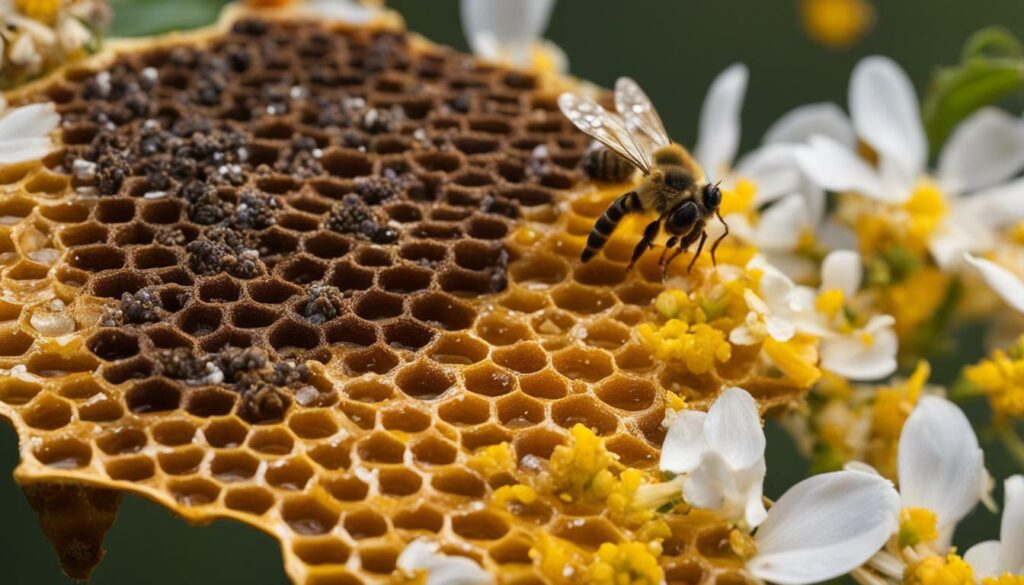
To further explore the symbolism of bee stings in mythology and love, let us delve into the stories and beliefs of other ancient cultures that provide insight into the profound meanings behind this intriguing symbolism.
Bee Sting Symbolism in Ancient Egyptian Mythology
In ancient Egyptian mythology, bees were believed to be a manifestation of the sun god Ra and were associated with royalty and the divine. They were seen as messengers of the gods, delivering prophecies and communicating divine will to humankind.
According to an Egyptian myth, the god Ra sent bees to sting humans as a form of divine punishment or retribution. The bee sting thus became a symbol of divine justice and consequence.
The Egyptians revered the bee for its industrious nature and organized social structure, seeing it as a symbol of community and cooperation. The sting of the bee represented not only the protective nature of the hive but also the preservation of order and balance in the world.
Bee Sting Symbolism in Norse Mythology
In Norse mythology, the bee sting was associated with the god Odin and his pursuit of knowledge and inspiration. It was believed that Odin gained wisdom and poetic inspiration by drinking honey from the Mead of Poetry, which was produced by bees that stung the giant Gunnlod.
The bee stings symbolized the sacrifices and challenges one must endure to attain wisdom and creative expression. It was a reminder that true knowledge and inspiration often come at a price and require dedication and perseverance.
“The bee stings symbolized the sacrifices and challenges one must endure to attain wisdom and creative expression.”
In addition to its association with wisdom, the bee and its sting were also seen as symbols of fertility and abundance in Norse mythology. Bees were believed to play a vital role in pollination and the growth of crops, linking them to the cycle of life and the abundance of the earth.
Interpretation of Bee Stings in Various Cultures
The interpretation of bee stings in mythology and love is not limited to ancient civilizations. In many cultures around the world, the bee sting continues to hold symbolic significance in relation to romantic relationships and the complexities of love.
For instance, in some Native American tribes, the bee sting is seen as a symbol of passionate love and desire. The intense pain caused by a bee sting represents the intensity of love, and the resulting swelling and redness symbolize the emotional turmoil that often accompanies love.
Similarly, in certain African cultures, the bee sting is associated with love and fidelity within marriage. It is believed that the pain of a bee sting strengthens the bond between spouses, reminding them of their commitment and dedication to each other.
These interpretations highlight the diverse and nuanced meanings behind bee sting symbolism in different cultures, emphasizing the universal themes of love, passion, and the complexities of human relationships.
Bee Sting Symbolism for Luck and Protection Against Evil
In some folklore and superstitions, the bee sting is believed to bring good luck or ward off evil spirits. The symbolic meaning of a bee sting holds significant spiritual significance in various cultures. It is often seen as a powerful symbol of protection, purification, and divine intervention.
“The bee stings, like a small yet mighty weapon, have long been regarded as a form of divine intervention in many cultures. It is believed that the sting of the bee carries the power to ward off evil spirits and protect individuals from harm,”
Throughout history, bees have been associated with the divine and spiritual realms. From ancient Egypt to Norse mythology, the bee has been considered a sacred creature tasked with safeguarding the natural order of the world. This belief in the protective properties of bee stings extends to individuals who embrace their symbolic meaning.
In the realm of folklore and superstition, bee stings are often seen as a lucky charm. It is believed that being stung by a bee brings good fortune, abundance, and success in various aspects of life. This notion reflects the idea of the bee as a hardworking creature that diligently gathers nectar and creates an abundance of honey, symbolizing prosperity and fruitful endeavors.
Furthermore, bee stings are thought to have purifying properties. It is believed that the venom of a bee sting can cleanse the body and spirit, ridding them of negative energies and promoting healing. This aligns with the spiritual significance of bee stings as a transformative experience, allowing individuals to shed their old selves and embrace personal growth.
The belief in the protective and lucky properties of bee stings has resulted in various rituals and practices aimed at harnessing their spiritual power. Some cultures perform ceremonies where individuals willingly subject themselves to bee stings, viewing it as a test of strength and a means of acquiring the blessings and favor of the divine.
However, it is important to note that the interpretation of bee sting symbolism can vary across different cultures and belief systems. While some see bee stings as a symbol of luck and protection, others may view them differently, associating bee stings with pain, aggression, or adversity.
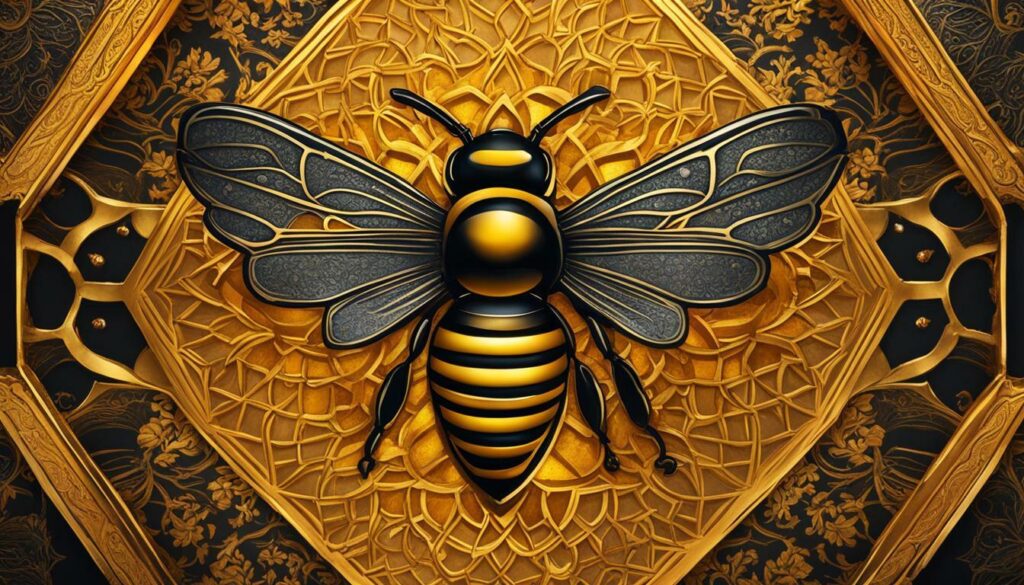
In conclusion, the symbolic meaning of bee stings encompasses a range of interpretations, including luck, protection against evil, and purification. While some folklore and superstitions view bee stings as a positive omen, it is essential to consider the varied perspectives and subjective nature of bee sting symbolism. Whether seen as a metaphorical sting of truth or a means of spiritual transformation, bee sting symbolism reflects the depth and complexity of human perception and belief.
The Subjectivity of Bee Sting Symbolism
While bee sting symbolism is fascinating, it is important to note that interpretations may vary across different cultures and belief systems. The symbolic interpretation of bee stings and the spiritual message they convey can be subjective, influenced by cultural context, personal experiences, and individual beliefs.
Throughout history, bee sting symbolism has been associated with a wide range of meanings and significance. In some cultures, a bee sting may be seen as a sign of protection against evil forces or a rite of passage into adulthood. In others, it may represent the interconnectedness of all living beings or serve as a metaphor for facing the consequences of our actions.
It is intriguing to explore the diverse interpretations of bee sting symbolism and understand how they shape our understanding of the world. Just as different cultures have unique languages and customs, they also have distinct symbolic systems that influence how they perceive and interpret the world around them.
To illustrate the subjectivity of bee sting symbolism, let’s consider three different cultural perspectives:
1. Native American Symbolism
In Native American cultures, bee stings symbolize the transformative power of nature and the importance of harmony with the natural world. The sting is seen as a wake-up call, urging individuals to reconnect with their environment and respect the delicate balance of life. It signifies the need to learn from the pain and embrace personal growth.
2. Hindu Symbolism
In Hinduism, bees are associated with the divine feminine and the goddess Kamadhenu, who is believed to grant wishes and bring prosperity. Bee stings are seen as a sign of blessings and good fortune, representing the protective nature of the goddess. They are also connected to the concept of self-sacrifice and devotion, as bees are known for their tireless work and dedication to their hive.
3. African Symbolism
In some African cultures, bee stings are associated with courage, resilience, and protection. It is believed that the sting of a bee can ward off evil spirits and protect against negative energies. Bees are seen as guardians and messengers, delivering spiritual messages and guiding individuals on their life journey.
These examples highlight the richness and complexity of bee sting symbolism and the different meanings it can hold. It is essential to approach the interpretation of bee stings with an open mind, respecting the diverse cultural perspectives and beliefs that shape their symbolism.
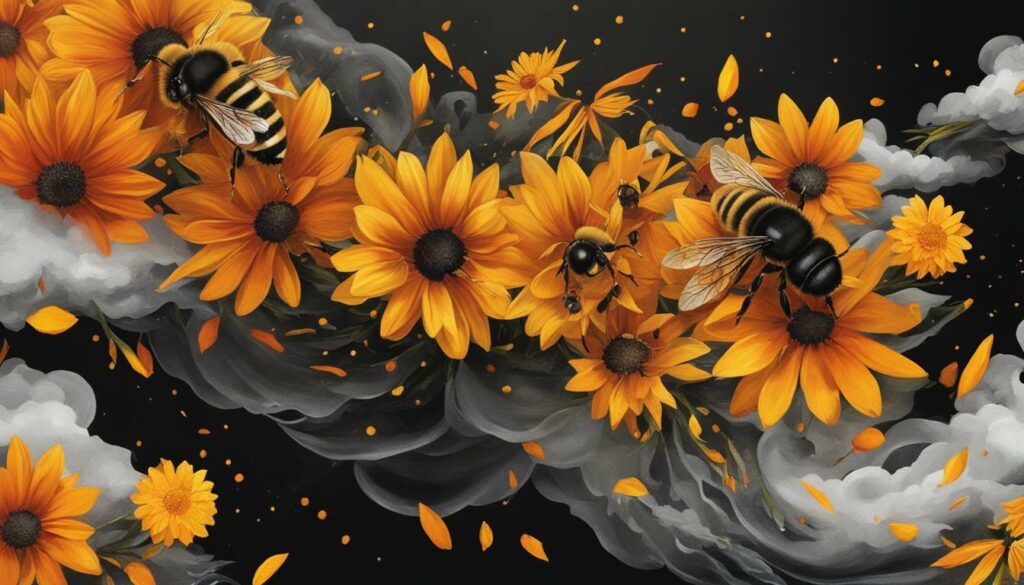
As we delve deeper into the exploration of bee sting symbolism, it becomes evident that the significance of bee stings extends far beyond their physical impact. They serve as powerful symbols, touching on various aspects of human existence, spirituality, and cultural identities.
By acknowledging the subjectivity of bee sting symbolism, we can gain a deeper appreciation for the diversity of human experiences and the multifaceted nature of symbolic interpretation. Whether viewed as a metaphorical sting of truth, a spiritual message, or a protective symbol, bee sting symbolism remains a captivating and thought-provoking topic.
Conclusion
In conclusion, the symbolism of bee stings is multifaceted and rich in meaning. Throughout various cultures and belief systems, bee sting symbolism holds significant spiritual significance and carries symbolic interpretations that delve into different aspects of life and human experiences.
The Bee as a Symbol of Community and Interconnectedness
One aspect of bee sting symbolism explores the profound connection between bees and the concept of community and interconnectedness. Bees are known for their highly organized social structure and cooperative behavior, which serves as a metaphor for the importance of unity and collaboration among individuals in society. The bee sting, in this context, symbolizes the interdependence of all living beings and the consequences that result from disrupting this delicate balance.
The Metaphorical Sting of Truth and Lessons Learned
Another interpretation of bee sting symbolism centers around the metaphorical sting of truth and the lessons learned through facing the consequences of our actions. Just as a bee sting can be painful, but ultimately teaches us to be more cautious and mindful, the sting serves as a reminder to reassess our choices and behaviors. It encourages personal growth and invites us to reflect on the impact of our decisions.
Bee Sting Symbolism in Healing and Transformation
For centuries, bee sting symbolism has been associated with healing and transformation. Some cultures believe that bee stings have therapeutic properties and can promote physical and spiritual healing. The venom of a bee sting is seen as a catalyst for transformation and a symbol of rebirth. It is believed to purge toxins from the body and facilitate a spiritual awakening, leading to personal growth and enlightenment.
The Bee Sting as a Rite of Passage
In certain cultures, bee sting ceremonies are used as part of initiation rituals, symbolizing the transition from childhood to adulthood. The bee sting represents the challenges and tests one must face to prove their readiness for a new stage in life. It is seen as a rite of passage that marks the beginning of greater responsibilities and the acquisition of wisdom.
Aggression, Protection, and Defense: The Darker Side of Bee Sting Symbolism
In contrast to the positive connotations, bee sting symbolism can also carry darker undertones. The bee sting is associated with aggression, protection, and the determination to stand up against adversity. Just as bees fiercely defend their hives, the sting symbolizes the fierce nature of standing up for what we believe in and protecting ourselves and those we care about.
Bee Sting Symbolism in Mythology and Love
Throughout ancient mythology, bee sting symbolism is often associated with love, desire, and the powerful nature of romantic relationships. Bees, with their pollinating abilities and role in the ecosystem, have been linked to fertility and the sweetness of love. The bee sting represents the intensity and transformative power of love, as well as the potential pain and pleasure that comes with it.
Bee Sting Symbolism for Luck and Protection Against Evil
Interestingly, bee sting symbolism is also believed to bring luck and protection against evil in some folklore and superstitions. It is seen as a purifying force that wards off negativity and ensures good fortune. Some cultures even use bee stings as talismans or charms for protection and prosperity.
The Subjectivity of Bee Sting Symbolism
It’s important to note that interpretations of bee sting symbolism can vary across different cultures and belief systems. The subjective nature of symbolism allows for personal and cultural perspectives to shape its meaning. Thus, bee sting symbolism can hold even deeper significance when viewed through the lens of an individual’s unique experiences and beliefs.
Overall, the symbolism of bee stings is a fascinating subject that reveals the intricate connections between nature, spirituality, and human experiences. The multifaceted nature of bee sting symbolism invites us to explore the deeper meanings behind this small but powerful creature and the lessons it imparts on our lives.
FAQ
Q: What is the spiritual significance of bee sting symbolism?
A: Bee sting symbolism holds different meanings across various cultures and belief systems. It is often seen as a message from the spiritual realm, representing transformation, healing, and the consequences of our actions.
Q: How is the bee sting symbolically interpreted?
A: The symbolic interpretation of bee stings revolves around themes such as community, interconnectedness, truth, protection, love, luck, and facing adversity. It can vary depending on the context and cultural background.
Q: What is the connection between bee stings and healing?
A: In certain cultures and alternative medicine practices, bee stings are believed to possess healing properties and are used for therapeutic purposes. They are thought to facilitate spiritual transformation and promote well-being.
Q: Are bee stings used in initiation rituals?
A: Yes, bee sting ceremonies are sometimes used as part of initiation rituals. They symbolize a rite of passage, marking the transition from childhood to adulthood and the journey of personal growth.
Q: How do bee stings relate to aggression and protection?
A: Bee sting symbolism can also be associated with aggression, protection, and the determination to defend oneself and others against adversity. It represents the strength and resilience needed to face challenges.
Q: What is the link between bee stings and mythology?
A: In ancient mythology, bee stings are often associated with love, desire, and the powerful nature of romantic relationships. They symbolize the intensity and passion found in these mythological love stories.
Q: Do bee stings have any protective properties?
A: Certain folklore and superstitions believe that bee stings can offer protection against evil and bring good luck. They are seen as a means of purification and warding off negative energies.
Q: Can the interpretation of bee sting symbolism vary?
A: Yes, the interpretation of bee sting symbolism can vary across different cultures and belief systems. It is subjective and influenced by individual perspectives and cultural contexts.
Please note that the FAQ section is provided as a sample structure. The actual questions and answers may vary based on the content of each section.
